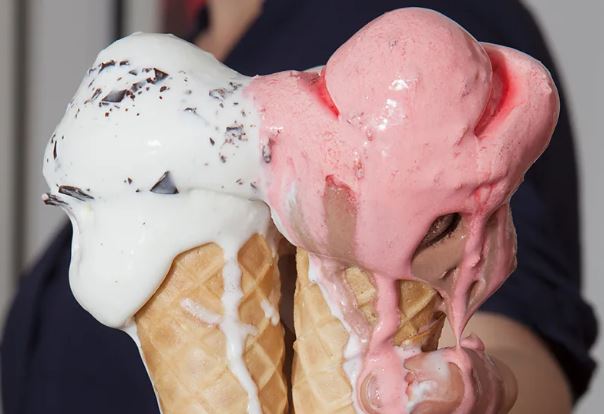
Ice cream is a staple of summer—but melts quickly when the mercury rises. Can scientists help it keep its cool?
Few things delight on a summer day like an ice cream cone.
Few things cause such despair, however, like the total disintegration of said ice cream, running down one's fingers, sagging from the cone, heading earthwards before you can say "toddler meltdown".
Any number of rhapsodies could be written about the pleasures of something so short-lived, all the sweeter for their brevity. But you would have to go to another story to find them, because here we will not tolerate such masochism.
Reports of Japanese manufacturer Kanazawa Ice's ice pops, and, later on, soft-serve ice cream, withstanding numerous heat-based assaults without melting, went viral some years ago, however.
The scientists behind this ice cream had pumped it full of polyphenols, a class of antioxidant molecules found in many fruits. The result was a curious stability, a notable lack of creamy liquid running over fingers. How did it work?
Ice cream is composed primarily of cream and sugar. Machines for producing the stuff churn the sweet slurry in a refrigerated drum, and when it forms a frozen film on the drum's interior, a scraper chips it off.
This keeps the ice crystals from growing to a distasteful size, the phenomenon behind the slightly jagged texture of some ice cream when you bring it home from the grocery store.
When ice cream, somewhere in the long trip between the factory and your freezer, heats up slightly, melts, and then is refrozen, chunky, unpleasant crystals result.
This is a known problem with taking ice cream from its first freezer into a world full of temperatures greater than zero.
Ice cream manufacturers already use a number of stabilisers, such as carrageenan, from seaweed, and guar gum (from guar seeds), to try to keep ice cream from suffering too much from its journeys.
"Ice cream that does not melt, that instead warms up into a rubbery monolith, is not really what most of us expect from a frozen dessert."
When Cameron Wicks, a food scientist then studying at the University of Wisconsin who now works at food producer General Mills, saw the video of Kanazawa Ice's no-melt ice cream, she wondered how the polyphenols had their stabilising effect.
The molecules are known for their potential health-promoting traits, not necessarily their engineering qualities. In the lab, she began to experiment with cream mixtures using higher and higher levels of one particular polyphenol: tannic acid.
Putting the cream under the microscope, Wicks saw that the higher concentrations had more distinct fat globules.
The tannic acid, she and her colleagues surmised, was interacting with the proteins in the cream, creating a supportive network or barrier to the merging of the fat globs.
That would explain why ice cream made from such a substance is resistant to melting: the liberated fats from the melted crystals of cream would not be able to run down, thanks to the addition of the polyphenol.
In experiments where she mixed cream with 0.75%, 1.5%, and 3% tannic acid, she noticed that almost immediately, the higher concentrations began to thicken.
After chilling the mixtures for 24 hours, she took measurements and noted that tannic acid had caused them to gel, so strongly that the 3% mixture could be cut with a knife or turned upside down without falling out of a cup.
That said, this chemical trick is not a way to freeze time and break the physical laws of the Universe. It's more like a bra for your ice cream—or a nice, supportive pair of dessert hosiery.
As the hours pass, Wicks found in later experiments, ice cream made this way acquires a pudding-like texture, although it will continue more or less in its previous shape. And polyphenols do not, of course, keep the ice cream cold.
Ice cream that does not melt, that instead warms up into a rubbery monolith, is not really what most of us expect from a frozen dessert.
Expectation matters more than you think when it comes to food. If you expect vanilla ice cream, and discover upon taking a bite that it is mashed potatoes, it is a profound readjustment.
Perhaps polyphenols will join the ranks of more established stabilisers, helping to keep ice cream more or less at it should be through the travails of long-distance travel. But will high-dose polyphenol desserts, designed to withstand a hair dryer's blast or to hold their shape for hours make their way to an ice cream stand near you? Only time will tell.
















